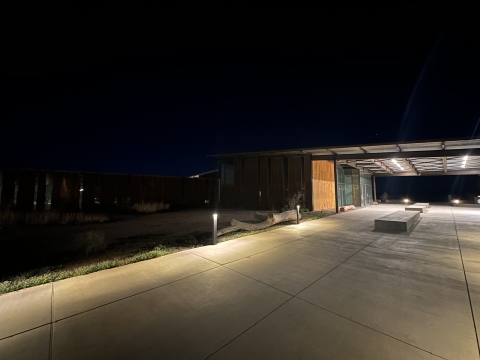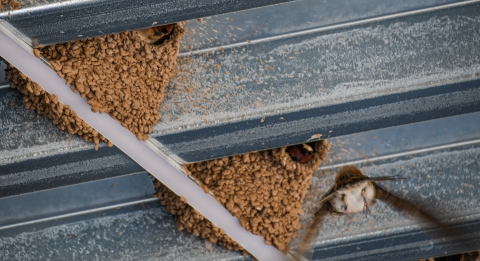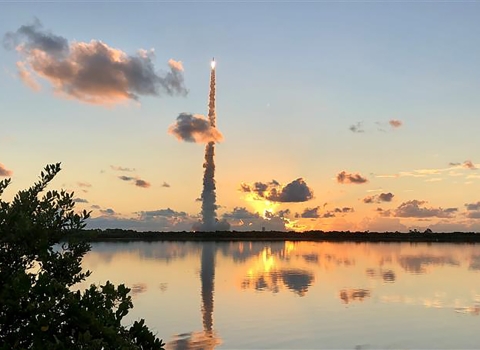ALBUQUERQUE, N.M.—The U.S. Green Building Council, the University of New Mexico, and the National Association for Industrial and Office Parks have honored the U.S. Fish and Wildlife Service’s Valle de Oro National Wildlife Refuge with awards for excellence in green building design and construction of the Refuge’s new headquarters and visitor center.
“We thought about sustainability kind of at every turn with everything we're doing with the visitor center, from the design and construction, the restoration around the building as well as the education pieces within the building,” said Refuge Manager Jennifer Owen-White, who’s been with at Valle de Oro since it was first established in 2013.
The U.S. Green Building Council’s Leadership in Energy and Environmental Design certification is a globally recognized symbol of sustainability achievement. Valle de Oro’s buildings achieved LEED Silver certification and shines as an example throughout the country for environmental friendliness toward the community and wildlife.
“The Refuge staff and the community were very heavily involved in this project at every step during the design and construction” said Project Architect Stephen Teeters of Formative Architecture. “Part of that involved honoring the land’s history, and the various people who have inhabited it. We partnered with Isleta Pueblo during the construction phase. The Refuge land was a dairy farm that is now being restored, and we were able to reuse and salvage many of the original structures. For example, an old hay storage structure structure
Something temporarily or permanently constructed, built, or placed; and constructed of natural or manufactured parts including, but not limited to, a building, shed, cabin, porch, bridge, walkway, stair steps, sign, landing, platform, dock, rack, fence, telecommunication device, antennae, fish cleaning table, satellite dish/mount, or well head.
Learn more about structure was retrofitted and reinforced and now serves as the new maintenance facility.”
The University of New Mexico’s School of Architecture honored Formative Architecture with its top Harner Award for Contemporary Architecture in the Southwest. “The refuge balances healthy natural habitat management with opportunities for education, visitor engagement, youth employment, community involvement and stewardship,” Teeters explained. “Another major aspect was making the structures bird friendly.”
It’s in bird-friendliness that the Refuge shines, in that it is not too shiny.
“To reduce bird collisions, we make the surfaces easily seeable by those birds.” Teeters explained. “We chose materials that aren't very shiny or reflective for the wall cladding, which was a natural rusted metal finish, and the glass has been acid glazed so birds can see it.”
Collisions with buildings are a leading human cause of bird deaths. Part of the Service’s Migratory Birds program involves educating the public and consulting with developers to minimize bird deaths, so it was important for the Refuge staff that they lead by example. A variety of bird experts were consulted during the design and building phases for the Refuge’s facilities.
“There are lots of opportunities when you're designing a building to avoid drawing birds in towards the glass,” said Pamela Toschik, Assistant Regional Director for the Migratory Birds Program for the Service’s Northeast Region. She leads a team working to reduce bird collisions across the Service. “There are also things people can do at home. Think about making your windows at home visible to birds, which could just be having external window screens, or could involve applying markings to the exterior of the glass spaced no more than two inches apart. There are products available to purchase that have been proven effective in reducing bird collisions, or people can design their own markers with paint or other products.
“Valle de Oro is also a model for wildlife-friendly lighting. When you have lights pointed into the sky at night, it can draw migrating birds in, trap them, and put them at risk of collisions with glass. Adjusting the light color to make it warmer is easier on birds. It’s also good to keep those lights on timers so they’re only on when needed. These are actions people can also take at home to reduce the impact of lighting on birds.”
Educating the public with interpretive displays and activities was another emphasis for Valle de Oro’s new facilities.
“When you come into the building there are interpretive panels that teach you about the bird friendly windows, our water collection systems that actually clean the water the help the local environment, our dark sky designation and work and the solar panels that power the facility,” said Owen-White. “So all the green features are interpreted for visitors to look at and learn about, so they can incorporate those features in their own homes and yards.”
Before the Valle de Oro National Wildlife Refuge began, the Valley of Gold Dairy was heavily used by the local community. Those community leaders came together to find a way to keep this land as an undeveloped, shared wild space that could be enjoyed by the public. They eventually decided it should be designated as a National Wildlife Refuge with the U.S. Fish and Wildlife Service in 2011.
The Refuge is in the Mountain View neighborhood, part of the greater Albuquerque South Valley area which is mainly Hispanic and lower income compared to the rest of the metropolitan area. Environmental justice has been a major priority for the Refuge since its inception.
“We can remember when the planes from the international airport flew so low over us it would cause everything here to shake,” remarked Richard Moore, a 56-year Mountain View resident who serves on Valle de Oro’s Environmental Justice Leadership Team. “Here in the South Valley, we are making big steps forward. We are the first national wildlife refuge national wildlife refuge
A national wildlife refuge is typically a contiguous area of land and water managed by the U.S. Fish and Wildlife Service for the conservation and, where appropriate, restoration of fish, wildlife and plant resources and their habitats for the benefit of present and future generations of Americans.
Learn more about national wildlife refuge or federal park in the country with an Environmental Justice Strategic Plan.”
The Refuge’s architecture and the interpretive activities reflect a theme of establishing a place of healing after so many years of colonization and industrial disruption to the residents — going back several hundreds of years in the past and recognizing its continuation to the present. These lands belonged to the Tiwa Puebloans, and more specifically, the Isleta Pueblo just south of the Refuge.
“As youths, the values we were taught about conservation are pretty much the same goals as the U.S. Fish and Wildlife Service and this Refuge. That is protecting these lands and resources for our children and future generations to come” said Isleta Pueblo Lt. Governor Virgil Lucero. “We have land for wildlife viewing on the Pueblo, but this Refuge provides many different activities like bicycling and bird watching areas, and being so close to us it provides our community with that safe place to go.”
Locations like Valle de Oro, that provide a Refuge for both wildlife and for people in an urban setting, go hand-in-hand with the goals of the highest levels of the Service and administration.
“The success of this refuge and community involvement is a testament to what a great job Jennifer Owen-White has done in working with the community,” said FWS Senior Advisor Jim Guthrie. “For the administration, projects like this are very important, because Environmental Justice is a major emphasis. This refuge is a prime example of what great things we can achieve when we involve partners and the local community.”
As for Refuge Manager Jennifer Owen-White, the journey has been long, but well worth it.
“There are around 200 partner organizations who have made this possible. l,” said Owen-White. “I was hired 10 years ago; I was the first employee. I promised myself that I would stay here for however long it would take to get this place established. We have more work to do, but this visitor’s center marks a big milestone for our community and for me personally, for all of us who have worked hand in hand to get to this point.”
Learn more about the awards:
U.S. Green Building Council Award
University of New Mexico Architecture Jeff Award
National Association for Industrial and Office Parks Awards
Valle de Oro National Wildlife Refuge Grand Opening Event Coverage
A Place for Learning and Connecting
Valle de Oro Wildlife Refuge Celebrates 10 Years with a New Visitor Center




